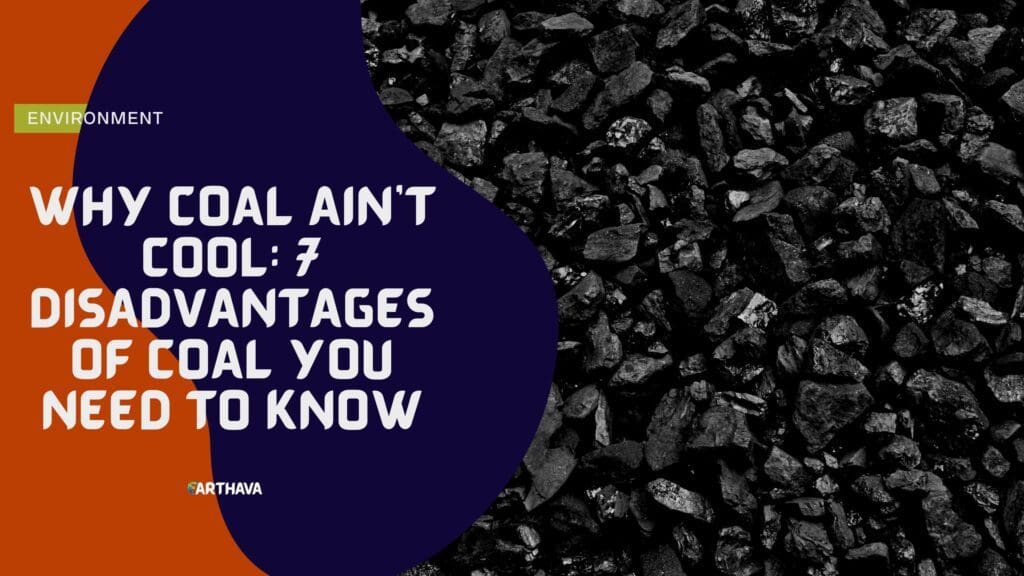Coal is a “fossil fuel” that we use as a major power source. Globally, we use over 8.7 million tons of coal per year, and that number is only growing. It’s evident that it’s an extremely vital part of the economy all around the world.

However, with all good things come the bad. In this article, you’ll learn about 7 disadvantages of coal and why we must find alternative resources that don’t harm the earth as much.
1. It Increases Carbon Dioxide in the Environment
When we burn coal, it produces extra carbon dioxide or CO2. CO2 causes a “greenhouse effect,” which means it makes the planet retain more heat in the lower atmosphere. As a result, this raises global warming, which can have devastating effects on the planet.
With global warming, it can melt glaciers, which causes sea levels to rise. Other seasonal events (like bird migration and flowering of plants) are also thrown off-track, which can lead to devastating effects.
2. It’ll Eventually Run out Someday
Yes, coal is a great resource that powers things on a global scale, but there’s only a finite amount of it. Today, it might seem like there’s a lot of coal to go around. But as usage increases with every year, the depletion of this precious resource may be sooner than you think.
Coal takes millions of years to form, which means we may be using up this finite resource faster than it can replenish itself. While some think coal will run out as early as 2052, and others think it can last a few more centuries, one thing is certainly clear: there is only so much coal on earth, and no matter how many more pockets of it we discover, we’ll eventually run out of coal.
3. Mining Displaces Wildlife and Humans Alike
Coal is typically found deep underground. However, there has to be a starting point on the surface to get to it. The more mining we do, the more wildlife habitats we destroy.
Not only does mining destroy habitats, but it also diminishes the ability of nature to provide adequate shelter for wildlife in the future. Coal mining tends to make the land barren and stripped. The loud sounds from the equipment may also scare off more timid animals.
Since the land becomes unstable, mining can also displace human beings. In areas where coal is found, people are forced to move away since the grounds can cave in at any given moment.
4. It Produces Acid Rain
Because of the increase of carbon dioxide in the atmosphere, it can result in acid rain. When this rainwater gets into lakes and streams, the change in pH can be harmful to the wildlife found in the bodies of water.
The rain can also cause trees in higher elevations to not receive as much nutrition. This is because there are acidic clouds and fog. This makes the trees less able to absorb sunlight, which weakens them.
Acid rain doesn’t hurt humans directly; it feels and looks like normal rain. However, the sulfur dioxide and nitrogen oxides in it can damage our lungs. It can also get into our groundwater, which can cause brain damage over time.
5. It’s Harmful to Miners’ Health
To get this precious resource, we need to send people down into coal mines to get it. They spend hours in the mines, and even with protective gear, they can still get something called “black lung disease.” This is the colloquial term for pneumoconiosis, which occurs when you inhale coal dust on a long-term basis.
Black lung disease causes lifelong symptoms and can end up being fatal. It’s also a precursor to lung cancer, so many coal miners have many health issues that end up threatening their lives.
6. Coal Is Radioactive
Not only does coal produce dust, but it also produces ash. This happens when it’s being burned for energy. The ash floats through the sky, meaning it can land far away from the original site if the wind is particularly strong.
Coal ash is highly radioactive and contains heavy metals, nitrous oxide, mercury, and other dangerous substances. In fact, the radioactivity of coal ash is 100 times more radioactive than the waste produced by nuclear power plants. Most people would think that coal is a lot less harmful than nuclear energy!
7. There Are High Levels of Waste
The levels of waste from coal mining total millions of tons. In just one decade, the US produced 1.2 billion tons of waste from coal mining. With all that waste, only about 40% of it is recycled.
And this is just America. Think of all the other countries that produce coal; they may have even higher waste production numbers and lower recycling statistics.
For all the waste that’s not recycled, it’s put into containment ponds or landfills. Our landfills are already filling up to the brim with other waste we can’t recycle, so just imagine the burden the waste from coal mining is adding to our trash problem. Not only that, but harmful byproducts are emanating from these waste products too.
The Disadvantages of Coal Are Significant
The disadvantages of coal are significant enough that we need to put an end to using this source of energy. If we want to leave this world a better place for our children, then finding renewable energy sources that leave smaller carbon footprints is a must.
Want to learn more about how you can do your part? Then read this article on 6 important tips on how to save the planet.


